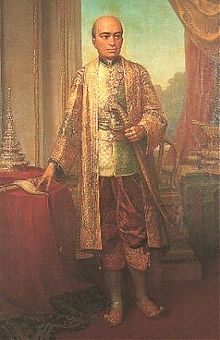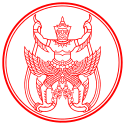| |
|---|---|
| King Rama II | |
 Portrait at the Grand Palace, Bangkok | |
| King of Siam | |
| Reign | 7 September 1809 – 21 July 1824 |
| Coronation | 17 September 1809 |
| Predecessor | Phutthayotfachulalok (Rama I) |
| Successor | Nangklao (Rama III) |
| Viceroy | Maha Senanurak (1809–1817) |
| Viceroy of Siam | |
| Tenure | 1808 – 7 September 1809 |
| Appointer | Phutthayotfachulalok (Rama I) |
| Predecessor | Maha Sura Singhanat |
| Successor | Maha Senanurak |
| Born | Chim (Itsarasunthon) 24 February 1767 Amphawa, Ayutthaya |
| Died | 21 July 1824 (aged 57) Bangkok, Siam |
| Spouse |
|
| Issue | 34 sons and 39 daughters,[1] including:
|
| House | Chakri dynasty |
| Father | Phutthayotfachulalok (Rama I) |
| Mother | Amarindra |
| Religion | Theravada Buddhism |
| Seal |  |
Phra Bat Somdet Phra Phutthaloetla Naphalai (Thai: พระบาทสมเด็จพระพุทธเลิศหล้านภาลัย, 24 February 1767 or 1768[2] – 21 July 1824), personal name Chim (Thai: ฉิม), also styled as Rama II, was the second King of Siam from the Chakri dynasty, ruling from 1809 to 1824. In 1809, Itsarasunthon succeeded his father Rama I, the founder of the Chakri dynasty, as Loetlanaphalai the King of Siam. His reign was largely peaceful, devoid of major conflicts. His reign was known as the "Golden Age of Rattanakosin Literature" as Loetlanaphalai was patron to a number of poets in his court, and the King himself was a renowned poet and artist. The most notable poet in his employ was the illustrious Sunthorn Phu, the author of Phra Aphai Mani. The rapid growth of the number of his descendants was outstanding: he is believed to have had over 240 grandchildren.
- ^ Baker, Chris; Phongphaichit, Phasuk (2009). A History of Thailand. Cambridge University Press. p. 31. ISBN 978-0521767682. Retrieved 10 July 2019.
- ^ "Rama II". britannica.com/. Encyclopædia Britannica. Retrieved 24 February 2021.